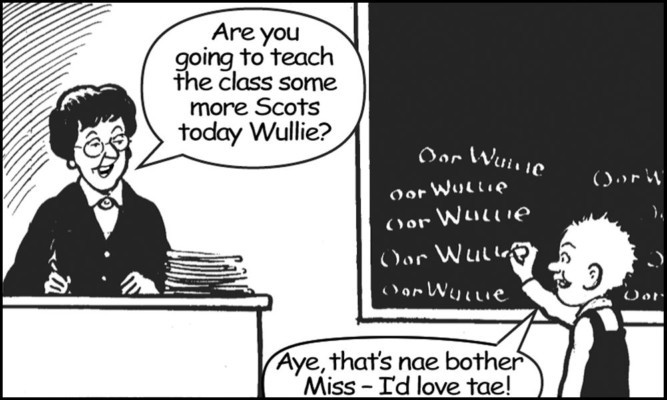
Oor Wullie isn’t exactly a teacher’s pet, so it might come as a michty big shock to hear that he’s turned to teaching bairns himself.
Not content with entertaining the nation with his adventures, Wullie’s set to help children to learn Scots in an online educational initiative developed by the National Library of Scotland in association with Sunday Post publisher DC Thomson.
The Oor Wullie Guide tae Scots Language website launches on Wednesday and is aimed at primary schools across Scotland. It will be used as a learning tool for six to 11-year-olds to help them become familiar with the Scots language. The website includes a range of activities designed to help children become more familiar with Scots words including quizzes, word searches, flash cards and the opportunity to design their own comic. An “audio map” feature will allow children to submit a recording of their own use of Scots and will build up a picture of dialects across Scotland.
DC Thomson and the NLS worked closely with each other in developing the website, which has also had input from pupils and teachers at a number of Scottish schools. The Scots Language Centre, the Scottish Language Dictionaries, the National Trust for Scotland and the Robert Burns Birthplace Museum are also partners in the project.
The website has been designed to fit the Curriculum of Excellence, which recognises that the languages, dialects and literature of Scotland provide a rich resource for children and young people to learn about the country’s culture and identity.

John Coll, the library’s head of access, said: “Learning languages enables children to develop the high-level skills in listening, talking, reading and writing which are essential for learning, work and life.
“The reading and speaking activities on the site will help pupils develop these skills while the drawing activities support creativity and expression through art and design.”
Oor Wullie editor Morris Heggie said: “The Scots language is an important part of Scottish culture and it has been a pleasure working with National Library of Scotland on this project.
“Oor Wullie has been fair thrilled at the response from children and everyone involved with the strip is rooting for the project to be a huge success.”
There’s just one word to describe the website BRAW!

Enjoy the convenience of having The Sunday Post delivered as a digital ePaper straight to your smartphone, tablet or computer.
Subscribe for only £5.49 a month and enjoy all the benefits of the printed paper as a digital replica.
Subscribe